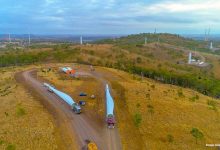AGL Energy says it is looking to boost its storage and flexible generation options as it eyes a share of what it describes as a $200 billion investment opportunity that will flow through the market from the clean energy transition.
In announcing its $1 billion net profit on Thursday, AGL noted that is has $1.5 billion in investments (two wind farms and a gas peaking plant) nearing completion, and another $2 billion in the pipeline.
This includes a 300MW solar farm in NSW (Wellington North), but CEO Brett Redman was particularly keen to point out two 250MW pumped hydro opportunities, each with eight hours storage: the Kanmantoo project in South Australia (where it is competing against about five other proposals), and the Bells Mountain project in NSW.
Curiously, unlike previous presentations, this project map above did not include the grid-scale batteries that AGL has talked about previously, including one at the site of the ageing and soon-to-close Liddell coal generator, and one at the soon-to-be-completed 453MW Cooper’s Gap wind farm, which for a while will be Australia’s biggest.
That, Redman insisted, was “more oversight than conspiracy.” He said Liddell and the neighbouring Bayswater coal generator were “natural place” for a grid-scale battery intalltion. He said the broader “battery thematic” is on its way, it was a question of economics he said, and how quickly costs are coming down.
Redman might have added, but didn’t, that’s it also a question of how quickly market rules can be adapted to recognise the multiple assets of these fast responding and versatile machines. Nevertheless, he assured us it will be a “big part of our future.”
 The $200 billion investment opportunity that Redman cited is actually taken from Bloomberg NEF analysis (see above), which identifies $70 billion in behind the meter, where AGL seems more comfortable playing at the moment, via its battery and virtual power plant offerings, and another $130 billion in the broader grid-scale part of the market.
The $200 billion investment opportunity that Redman cited is actually taken from Bloomberg NEF analysis (see above), which identifies $70 billion in behind the meter, where AGL seems more comfortable playing at the moment, via its battery and virtual power plant offerings, and another $130 billion in the broader grid-scale part of the market.
But here’s the curious thing, and it helps put AGL’s dilemma in perspective. Right now, as its results show, it’s making bucket loads of money from its coal generators, which contribute more than 85 per cent of its generation.
That is expected to continue for a while. It may be closing down Liddell earlier than the Coalition and the coal lobby would like, but it intends to hang on to its other coal assets for as long as it can.
The remaining thermal fleet (principally Loy Yang A in Victoria and Bayswater in NSW) are among youngest and highest quality plant in the system, and “will be around for longest”, he said. Its timeline for closure remains at 2036 (Bayswater) and 2048 (Loy Yang A) – that’s the lingering grey line in the graph above.
Neither fit neatly into a Paris climate trajectory, which may be one of a number of reasons why AGL’s management has advised shareholders to reject a resolution calling on the company, Australia’s largest greenhouse gas emitter, to reduce emissions in line with the climate goals of the Paris Agreement.
But keeping this “young and high quality” thermal fleet operating is a costly business. AGL this year will be hit by a loss of up to $100 million from the cost of sorting at problems at the Loy Yang 2 unit.
But just keeping everything online will cost about $350 million in capex a year. And this graph above highlights just how much that capital spend dominates its budgeting. Renewables and residential battery programs are barely a blip.












